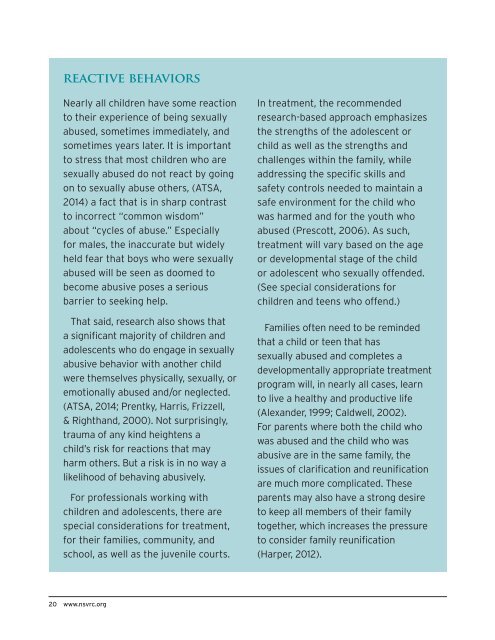Considering Family Reconnection and Reunification after Child Sexual Abuse
1VwGeds
1VwGeds
You also want an ePaper? Increase the reach of your titles
YUMPU automatically turns print PDFs into web optimized ePapers that Google loves.
Reactive behaviors<br />
Nearly all children have some reaction<br />
to their experience of being sexually<br />
abused, sometimes immediately, <strong>and</strong><br />
sometimes years later. It is important<br />
to stress that most children who are<br />
sexually abused do not react by going<br />
on to sexually abuse others, (ATSA,<br />
2014) a fact that is in sharp contrast<br />
to incorrect “common wisdom”<br />
about “cycles of abuse.” Especially<br />
for males, the inaccurate but widely<br />
held fear that boys who were sexually<br />
abused will be seen as doomed to<br />
become abusive poses a serious<br />
barrier to seeking help.<br />
That said, research also shows that<br />
a significant majority of children <strong>and</strong><br />
adolescents who do engage in sexually<br />
abusive behavior with another child<br />
were themselves physically, sexually, or<br />
emotionally abused <strong>and</strong>/or neglected.<br />
(ATSA, 2014; Prentky, Harris, Frizzell,<br />
& Righth<strong>and</strong>, 2000). Not surprisingly,<br />
trauma of any kind heightens a<br />
child’s risk for reactions that may<br />
harm others. But a risk is in no way a<br />
likelihood of behaving abusively.<br />
For professionals working with<br />
children <strong>and</strong> adolescents, there are<br />
special considerations for treatment,<br />
for their families, community, <strong>and</strong><br />
school, as well as the juvenile courts.<br />
In treatment, the recommended<br />
research-based approach emphasizes<br />
the strengths of the adolescent or<br />
child as well as the strengths <strong>and</strong><br />
challenges within the family, while<br />
addressing the specific skills <strong>and</strong><br />
safety controls needed to maintain a<br />
safe environment for the child who<br />
was harmed <strong>and</strong> for the youth who<br />
abused (Prescott, 2006). As such,<br />
treatment will vary based on the age<br />
or developmental stage of the child<br />
or adolescent who sexually offended.<br />
(See special considerations for<br />
children <strong>and</strong> teens who offend.)<br />
Families often need to be reminded<br />
that a child or teen that has<br />
sexually abused <strong>and</strong> completes a<br />
developmentally appropriate treatment<br />
program will, in nearly all cases, learn<br />
to live a healthy <strong>and</strong> productive life<br />
(Alex<strong>and</strong>er, 1999; Caldwell, 2002).<br />
For parents where both the child who<br />
was abused <strong>and</strong> the child who was<br />
abusive are in the same family, the<br />
issues of clarification <strong>and</strong> reunification<br />
are much more complicated. These<br />
parents may also have a strong desire<br />
to keep all members of their family<br />
together, which increases the pressure<br />
to consider family reunification<br />
(Harper, 2012).<br />
20 www.nsvrc.org


